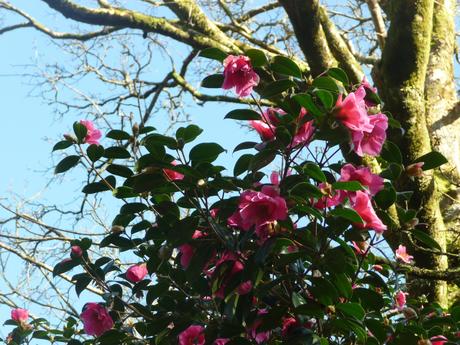Signs of spring are everywhere. Birds sing to celebrate the lengthening days and to attract mates and Snowdrops and Daffodils pierce through the soil, assuring us that all is well and another year in the garden is beginning. Catkins on Hazel trees lengthen with the days and the bare wood of Viburnum x bodnantense and shrubby Honeysuckle is festooned with scented blooms as are the evergreen shrubs Sarcococca and Skimmia which can fill a garden with their powerful scent. Early varieties of Camellias display their flouncy flowers in creamy white and sugar pink whilst later varieties, along with Rhododendrons, bristle with plump buds waiting to smother their bearers in blooms and light up partly shaded borders or create a stunning focal point on a path in a glade.
Snowdrops and Daffodils pierce through the soil, assuring us that all is well and another year in the garden is beginning. Catkins on Hazel trees lengthen with the days and the bare wood of Viburnum x bodnantense and shrubby Honeysuckle is festooned with scented blooms as are the evergreen shrubs Sarcococca and Skimmia which can fill a garden with their powerful scent. Early varieties of Camellias display their flouncy flowers in creamy white and sugar pink whilst later varieties, along with Rhododendrons, bristle with plump buds waiting to smother their bearers in blooms and light up partly shaded borders or create a stunning focal point on a path in a glade.
Magnolias too, are full of furry buds on the bare wood, waiting to open as the leaves begin to appear – a beautiful, if fleeting sight. The Himalayan Tulip Trees (Magnolia campbellii) can be seen in flower in many of the great Cornish gardens from the end of February through March although much neck craning is required to appreciate these giants. They are a long term project that needs plenty of space and waiting time to see the sumptuous blooms. The Star Magnolia (M. stellata) is a much smaller relative with ragged white blooms from March until April – a much better bet for modern gardens and guaranteed to be smothered in flowers each year as long as the dreaded late frosts do not strike.
Perennials and ornamental grasses begin to show green shoots, soon to cover the earth for another season but some are in flower early. The Lenten Rose (Helleborus) shyly raise their heads of green buds which will soon open to dusky coloured flowers - a treat for gardeners and bees alike whilst the spotted leaves of Lungwort (Pulmonaria) surround flower buds that carry tubular blooms for months until late spring and are another favorite with bees.
Bare coloured stems of Dogwoods and Willows can still be enjoyed before the leaves appear to disguise them but if they need to be pruned do it now, by taking the twigs back to a basic framework a few inches from the ground or to the top of the trunk in the case of Willows that are grown on a stem.
The riotous spring show does not begin in earnest for a few weeks yet but the classic shrubs that we all look to for color are full of still dormant flower buds, waiting to stir into action once the weather warms and the days get longer. Forsythia and Ribes (Flowering Currant) are two such stalwarts that hit the accelerator early in the year along with flowering Quince (Chaenomeles) that begins to bloom on the bare wood and continues for months - long after the glossy green leaves have appeared. The sweet scent of spring flowering Viburnums that include V. x carlcephalum and the pink budded V. x carlesii are other shrubs that are a delight in spring but for now sit in suspended animation waiting to unleash their scent and beauty on us once again.
